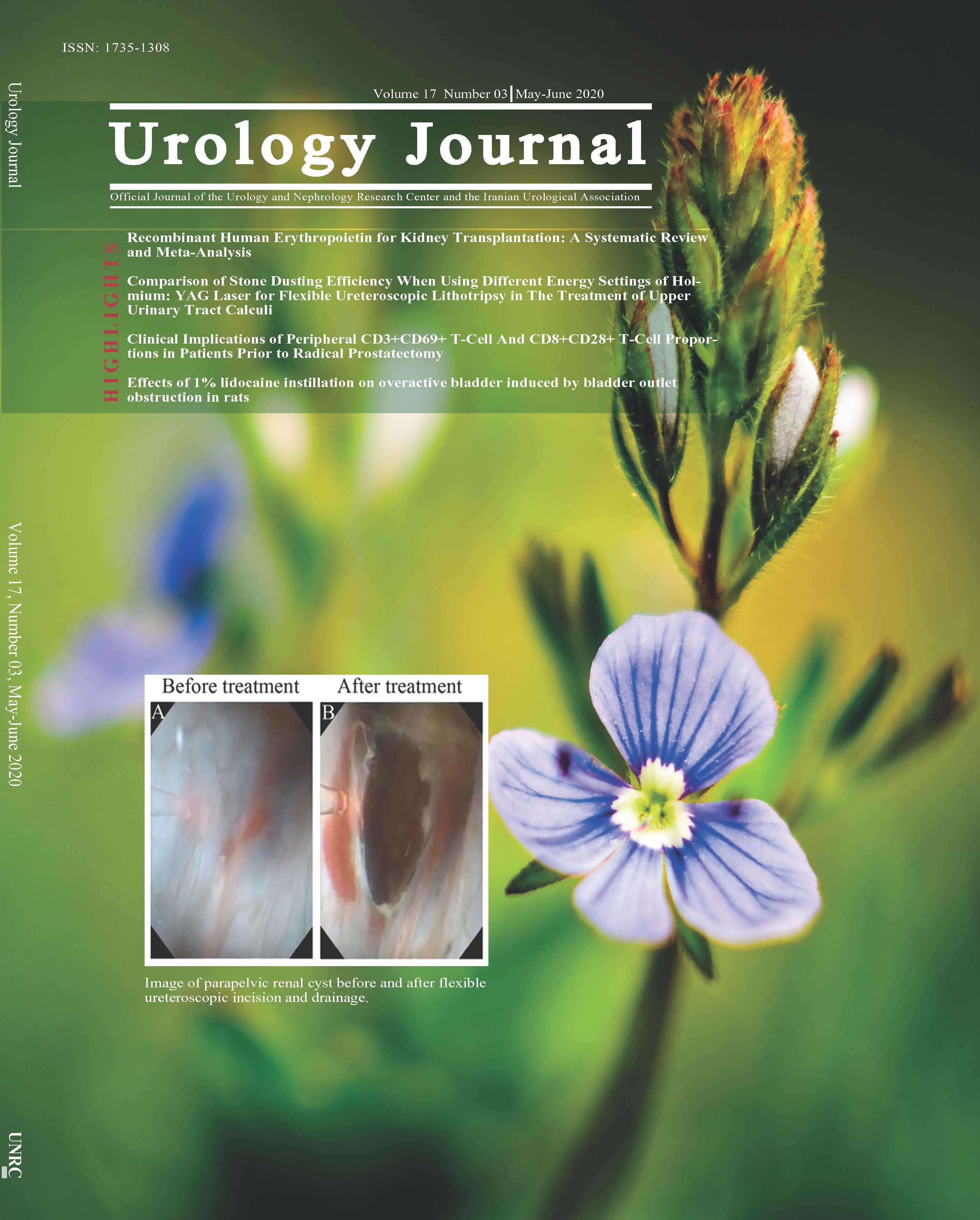Clinical Implications of Peripheral CD3+CD69+ T-Cell And CD8+CD28+ T-Cell Proportions in Patients Prior to Radical Prostatectomy
Urology Journal,
Vol. 17 No. 3 (2020),
16 May 2020
,
Page 257-261
https://doi.org/10.22037/uj.v17i3.5103
Abstract
Purpose: To investigate the clinical implications of CD3+CD69+ T-cells and CD8+CD28+ T-cells in the peripheral blood of patients prior to radical prostatectomy.Materials and Methods: A total of 91 prostate cancer (PCa) patients and 50 benign prostatic hyperplasia (BPH) patients were enrolled from January 2016 to December 2017. The proportions of CD3+CD69+ T-cells and CD8+CD28+ T-cells in the peripheral blood of PCa and BPH patients were detected by flow cytometry, and the association of these T-cell populations with pathological Grade Group and pathological TNM classification was evaluated. Data analysis was performed with SAS version 9.4 software.
Results: The proportions of CD3+CD69+ and CD8+CD28+ T-cells in peripheral blood were higher in PCa patients than those in BPH patients. Multivariate analysis identified a higher CD3+CD69+ T-cell proportion as a risk factor for PCa (odds ratio (OR) = 4.783, P = 0.0013), but the diagnostic efficacy of the CD3+CD69+ T-cell proportion (area under the curve (AUC)=0.6833, P = 0.0003) for PCa was still inferior to that of the tPSA level (AUC=0.7531, P < 0.0001). The AUCs for CD3+CD69+ T-cell and CD8+CD28+ T-cell proportions for PCa were 0.6959 (P = 0.0372) and 0.6935 (P = 0.0395), respectively, among men with tPSA levels of 4.0-10.0 ng/mL. A lower CD3+CD69+ T-cell proportion was associated with higher pathological Grade Group (P=0.0074).
Conclusion: The proportions of CD3+CD69+ T-cells and CD8+CD28+ T-cells in peripheral blood are potential diagnostic indicators for PCa. The preoperative proportion of CD3+CD69+ T-cells in peripheral blood may have prognostic value in terms of the pathological Grade Group in PCa.
- CD3 CD69 T-cell
- CD8 CD28 T-cell
- immune function
- prostate cancer
- radical prostatectomy
How to Cite
References
Siegel RL, Miller KD and Jemal A. Cancer statistics, 2018. CA Cancer J Clin 2018; 68: 7-30.
Gamat M, McNeel DG. Androgen deprivation and immunotherapy for the treatment of prostate cancer. Endocr Related Cancer 2017;24(12):T297-T310.
Wang ZK, Yang B, Liu H, et al. Regulatory T cells increase in breast cancer and in stage IV breast cancer. Cancer Immunol Immunother 2012; 61: 911-916.
Krupnick AS, Kreisel D, Szeto WY, et al. Multiparameter flow cytometric approach for simultaneous evaluation of T lymphocyte-endothelial cell interactions. Cytometry 2001; 46: 271-280.
Frydecka I, Kosmaczewska A, Bocko D, et al. Alterations of the expression of T-cell-related costimulatory CD28 and downregulatory CD152 (CTLA-4) molecules in patients with B-cell chronic lymphocytic leukaemia. Br J Cancer 2004; 90: 2042-2048.
Bocko D, Kosmaczewska A, Ciszak L, Teodorowska R and Frydecka I. CD28 costimulatory molecule--expression, structure and function. Arch Immunol Ther Exp (Warsz) 2002; 50: 169-177.
Martin P, Gomez M, Lamana A, et al. CD69 association with Jak3/Stat5 proteins regulates Th17 cell differentiation. Mol Cell Biol 2010; 30: 4877-4889.
Martin P and Sanchez-Madrid F. CD69: an unexpected regulator of TH17 cell-driven inflammatory responses. Sci Signal 2011; 4: pe14.
Esplugues E, Sancho D, Vega-Ramos J, et al. Enhanced antitumor immunity in mice deficient in CD69. J Exp Med 2003; 197: 1093-1106.
Yang W, Jia X, Su Y and Li Q. Immunophenotypic characterization of CD45RO+ and CD45RA+ T cell subsets in peripheral blood of peripheral T cell lymphoma patients. Cell Biochem Biophys 2014; 70: 993-997.
Mottet N, Bellmunt J, Bolla M, et al. EAU-ESTRO-SIOG Guidelines on prostate cancer. Part 1: screening, diagnosis, and local treatment with curative intent. Eur Urol 2017; 71: 618-629.
Cuzick J, Thorat MA, Andriole G, et al. Prevention and early detection of prostate cancer. Lancet Oncol 2014; 15: e484-e492.
Lee DJ, Ahmed HU, Moore CM, Emberton M and Ehdaie B. Multiparametric magnetic resonance imaging in the management and diagnosis of prostate cancer: current applications and strategies. Curr Urol Rep 2014; 15: 390.
Yang Z, Yu L and Wang Z. PCA3 and TMPRSS2-ERG gene fusions as diagnostic biomarkers for prostate cancer. Chin J Cancer Res 2016; 28: 65-71.
Katafigiotis I, Tyritzis SI, Stravodimos KG, et al. Zinc alpha2-glycoprotein as a potential novel urine biomarker for the early diagnosis of prostate cancer. BJU Int 2012; 110: E688-693.
Starska K, Glowacka E, Kulig A, Lewy-Trenda I, Brys M and Lewkowicz P. Prognostic value of the immunological phenomena and relationship with clinicopathological characteristics of the tumor--the expression of the early CD69+, CD71+ and the late CD25+, CD26+, HLA/DR+ activation markers on T CD4+ and CD8+ lymphocytes in squamous cell laryngeal carcinoma. Part II. Folia Histochem Cytobiol 2011; 49: 593-603.
Epstein JI, Pound CR, Partin AW and Walsh PC. Disease progression following radical prostatectomy in men with Gleason score 7 tumor. J Urol 1998; 160: 97-100; discussion 101.
Pins MR, Fiadjoe JE, Korley F, et al. Clusterin as a possible predictor for biochemical recurrence of prostate cancer following radical prostatectomy with intermediate Gleason scores: a preliminary report. Prostate Cancer Prostatic Dis 2004; 7: 243-248.
Lee H, Jeong SJ, Hong SK, Byun SS, Lee SE and Oh JJ. High preoperative neutrophil-lymphocyte ratio predicts biochemical recurrence in patients with localized prostate cancer after radical prostatectomy. World J Urol 2016; 34: 821-827.
- Abstract Viewed: 410 times
- pdf/5103 Downloaded: 155 times
